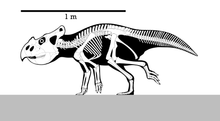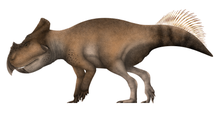Bagaceratops
| Bagaceratops Temporal range: Late Cretaceous,
~ | |
|---|---|

| |
| Skeletal reconstruction | |
| Scientific classification | |
| Kingdom: | Animalia |
| Phylum: | Chordata |
| Clade: | Dinosauria |
| Order: | †Ornithischia |
| Suborder: | †Ceratopsia |
| Parvorder: | †Coronosauria |
| Family: | †Protoceratopsidae |
| Genus: | †Bagaceratops Maryanska & Osmolska, 1975 |
| Type species | |
| †Bagaceratops rozhdestvenskyi Maryanska & Osmolska, 1975
| |
| Synonyms | |
| |
Bagaceratops (meaning "small-horned face") is a genus of ceratopsian dinosaur that lived in what is now the Barun Goyot Formation and Bayan Mandahu Formation, during the Late Cretaceous. One specimen may argue the possible presence of Bagaceratops in the Djadochta Formation. Although emerging late in the reign of the dinosaurs, Bagaceratops had a fairly primitive anatomy—when compared to other much derived ceratopsians—and kept the small body size that characterized early ceratopsians.
History of discovery[]

The first remains of Bagaceratops were discovered in the Gobi Desert during the 1970s by a joint expedition composed of Mongolian and Polish scientists and it was described in 1975 by two of the expedition's leading scientists, Teresa Maryanska and Halszka Osmólska. Several of these Bagaceratops specimens are at Poland's in Warsaw. The holotype is ZPAL MgD-I/126, a medium-sized skull from the Hermiin Tsav locality of the Barun Goyot Formation, during the Campanian stage of the Late Cretaceous. The generic name, Bagaceratops, means "small-horned face" and is derived from the Mongolian Baga = "small"; Greek ceratops = "horn face". The type and only species, B. rozhdestvenskyi, was named in honor of the Russian paleontologist Anatoly Konstantinovich Rozhdestvensky.[1]
Bagaceratops is known from five complete and twenty partial crania, the longest of which is 17 cm long. The skulls are spread throughout the life stages of the animal, with the smallest being only 4.7 cm long, so the growth stages are relatively well understood. The smaller juvenile skulls were about the same size as a golf ball. Only fragmentary remains of Bagaceratops post-cranial anatomy have been found. Juvenile remains, at first tentatively named Protoceratops kozlowskii, and then renamed Breviceratops kozlowskii by Kurzanov in 1990 are now felt to be juvenile Bagaceratops. Paul Sereno in 2000 explained this by extrapolating that the juvenile Breviceratops would grow into a mature Bagaceratops.[2]


In 1993, JMPJE collected the articulated and nearly complete Bagaceratops skeleton (MPC-D 100/535) from the Barun Goyot Formation at the Hermiin Tsav locality.[3] In 2010 and 2011 this specimen was examined to analyze several borings (tunnel-like holes) left by invertebrae scavengers on joint areas.[4][5] As of 2019, MPC-D 100/535 remains largely undescribed.[6] In 2019 a partial skeleton (specimen KID 196) of Bagaceratops was described by Bitnara Kim and colleagues, who noted no significant diifferences between the skeleton of Protoceratops and the former. This specimen was discovered in 2007 also from the Hermiin Tsav locality of the Barun Goyot Formation, and includes a partially preserved skull with partial skeleton of an adult individual.[6]
A study on the nature of the observed variation in morphology and size of skulls of Bagaceratops was performed by Łukasz Czepiński in 2019, who also considered the species Gobiceratops minutus, Lamaceratops tereschenkoi, Platyceratops tatarinovi and Magnirostris dodsoni to be potential growth stages of B. rozhdestvenskyi and therefore, junior synonyms.[7] In 2020, Czepiński described new specimens of Bagaceratops and Protoceratops from the Üüden Sair and Zamyn Khond localities of the Barun Goyot Formation or Djadochta Formation, and evaluated the implications of these specimens for correlation of fossil sites of the latter formation. He considered one of these specimens in particular, MPC-D 100/551B, as a potential evidence of an anagenetic transition from Protoceratops andrewsi to Bagaceratops rozhdestvenskyi.[8]
Description[]
Bagaceratops grew to an adult size of about 1 metre (3.3 ft) long, 50 centimetres (1.6 ft) high, and weighed around 22 kilograms (50 lb). It had a smaller frill (which lacked fenestrae), and only ten grinding teeth per jaw, and more triangular skull than its close relative, Protoceratops.[2]
Bagaceratops evolved later but retains more primitive characteristics than its earlier relative. Otherwise the two dinosaurs were very similar, each had a beak but no brow horns, and a small horn-like prominence on the snout.[2]
Classification[]

Bagaceratops belonged to the Ceratopsia, a group of herbivorous dinosaurs with parrot-like beaks which thrived in North America and Asia during the Cretaceous Period, which ended roughly 66 million years ago.
In 2019 Czepiński analyzed a vast majority of referred specimens to the ceratopsians Bagaceratops and Breviceratops, and concluded that most were in fact specimens of the former. Although the genera Gobiceratops, Lamaceratops, Magnirostris, and Platyceratops, were long considered valid and distinct taxa, and sometimes placed within Protoceratopsidae, Czepiński found the diagnostic features used to distinguish these taxa to be largely present in Bagaceratops and thus becoming synonyms of this genus. Under this reasoning, Protoceratopsidae consists of Bagaceratops, Breviceratops, and Protoceratops. Based on cranial characters such as presence or absence of premaxillary teeth and an antorbital fenestra, P. andrewsi is the basal-most protoceratopsid and Bagaceratops the derived-most one. Below are the proposed phylogenetic relationships within Protoceratopsidae by Czepiński:[7]
| Protoceratopsidae |
| ||||||||||||||||||||||||
Diet[]
Bagaceratops, like all ceratopsians, was a herbivore. During the Cretaceous, flowering plants were "geographically limited on the landscape", and so it is likely that this dinosaur fed on the predominant plants of the era: ferns, cycads and conifers. It would have used its sharp ceratopsian beak to bite off the leaves or needles.
See also[]
References[]
- ^ Maryańska, T and H. Osmólska (1975). "Protoceratopsidae (Dinosauria) of Asia." Palaeontologia Polonica 33 (1975): 133-181.
- ^ a b c "Bagaceratops." In: Dodson, Peter & Britt, Brooks & Carpenter, Kenneth & Forster, Catherine A. & Gillette, David D. & Norell, Mark A. & Olshevsky, George & Parrish, J. Michael & Weishampel, David B. The Age of Dinosaurs. Publications International, LTD. p. 132. ISBN 0-7853-0443-6.
- ^ Watabe, M., Suzuki, S., 2000a. Report on the Japan Mongolia joint paleontologicalexpedition to the Gobi desert, 1993. Hayashibara Museum of Natural SciencesResearch Bulletin 1, 17 29.
- ^ Matsumoto, Y.; Saneyoshi, M. (2010). "Bored dinosaur skeletons". The Journal of the Geological Society of Japan. 116 (1): 1−2. doi:10.5575/geosoc.116.1.I_II.
- ^ Saneyoshi, M.; Watabe, M.; Suzuki, S.; Tsogtbaatar, K. (2011). "Trace fossils on dinosaur bones from Upper Cretaceous eolian deposits in Mongolia: Taphonomic interpretation of paleoecosystems in ancient desert environments". Palaeogeography, Palaeoclimatology, Palaeoecology. 311 (1–2): 38−47. Bibcode:2011PPP...311...38S. doi:10.1016/j.palaeo.2011.07.024.
- ^ a b Kim, B.; Yun, H.; Lee, Y.-N. (2019). "The postcranial skeleton of Bagaceratops (Ornithischia: Neoceratopsia) from the Baruungoyot Formation (Upper Cretaceous) in Hermiin Tsav of southwestern Gobi, Mongolia". Journal of the Geological Society of Korea. 55 (2): 179−190. doi:10.14770/jgsk.2019.55.2.179. S2CID 150321203.
- ^ a b Czepiński, Ł. (2019). "Ontogeny and variation of a protoceratopsid dinosaur Bagaceratops rozhdestvenskyi from the Late Cretaceous of the Gobi Desert" (PDF). Historical Biology. 32 (10): 1394–1421. doi:10.1080/08912963.2019.1593404. S2CID 132780322.
- ^ Czepiński, Ł. (2020). "New protoceratopsid specimens improve the age correlation of the Upper Cretaceous Gobi Desert strata". Acta Palaeontologica Polonica. 65 (3): 481−497. doi:10.4202/app.00701.2019.
External links[]
- Late Cretaceous dinosaurs of Asia
- Coronosaurs
- Fossil taxa described in 1975
- Taxa named by Halszka Osmólska
- Taxa named by Teresa Maryańska
- Ornithischian genera





